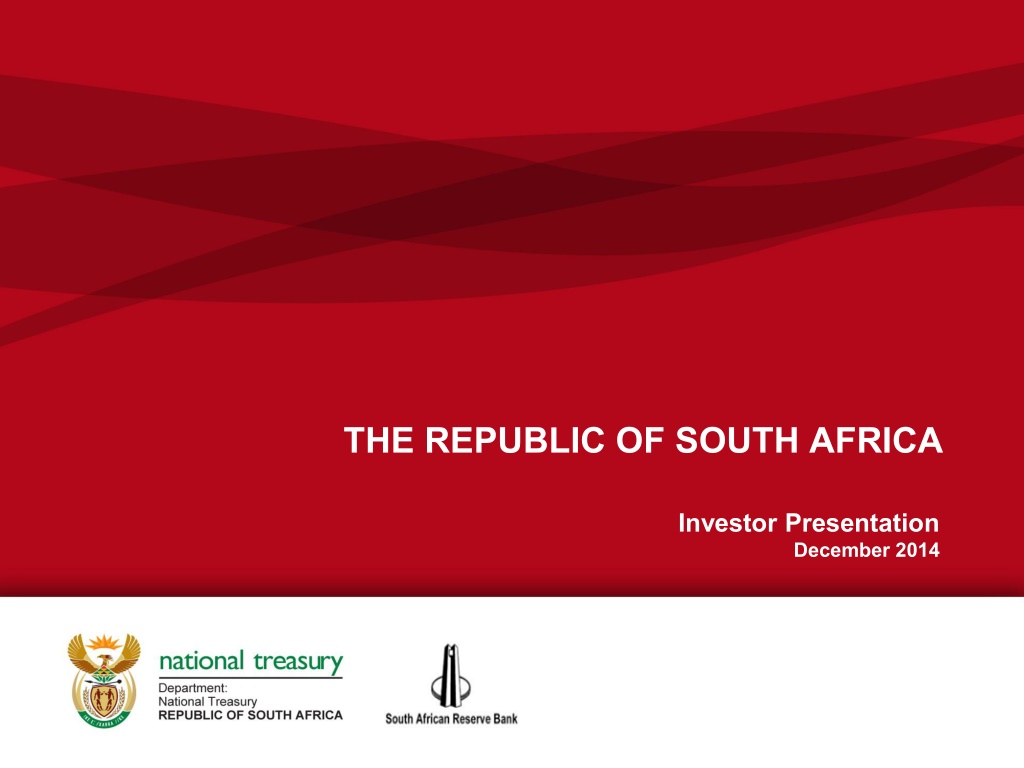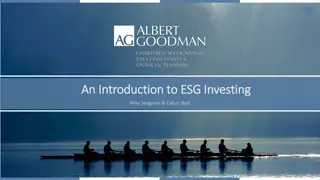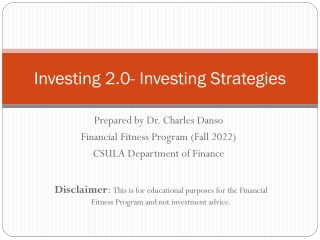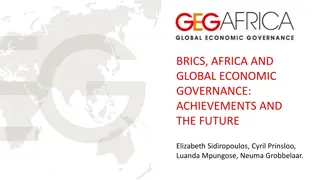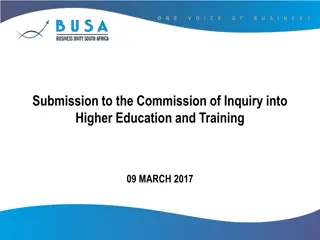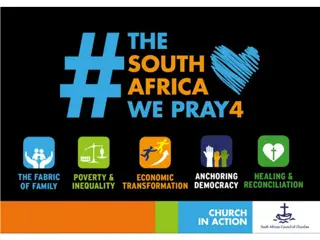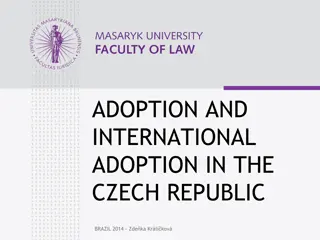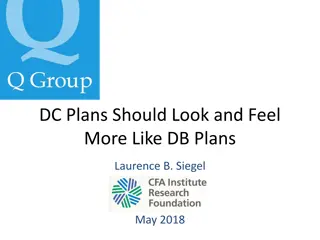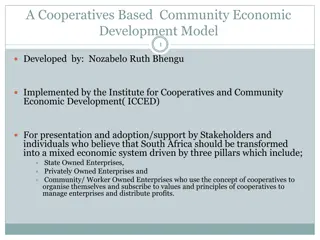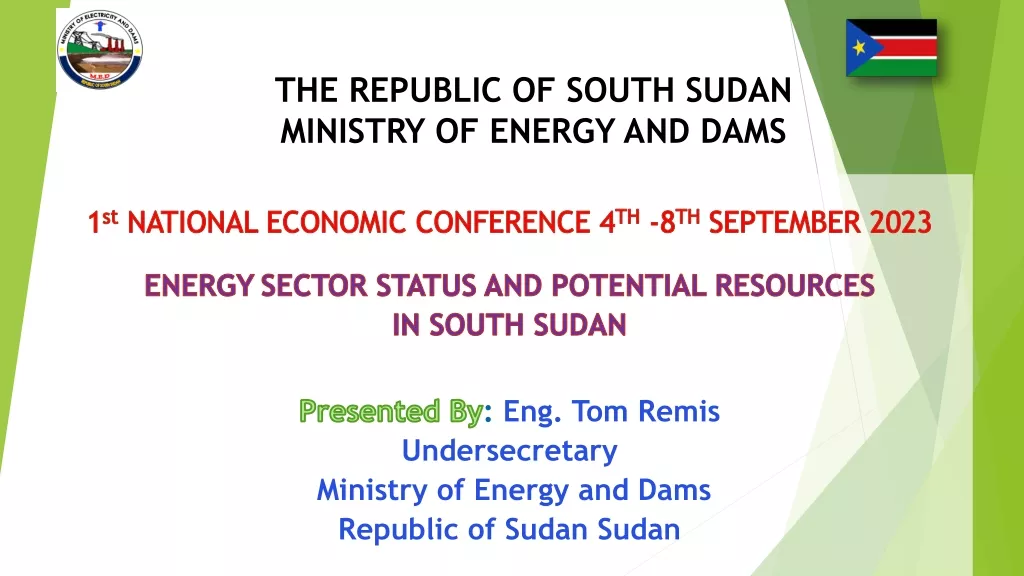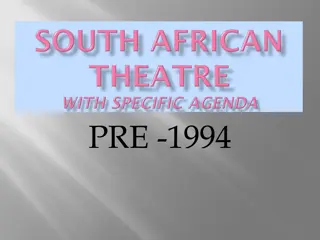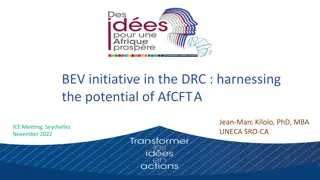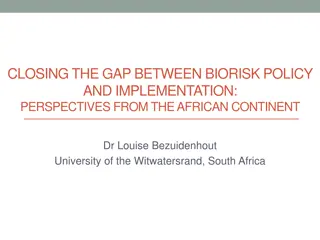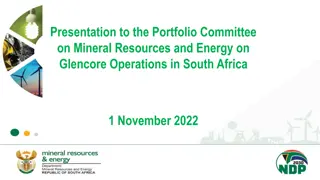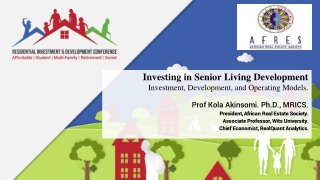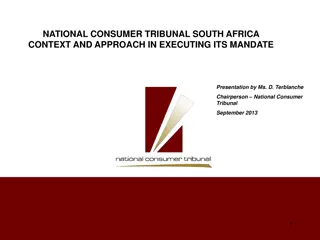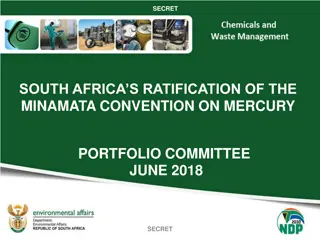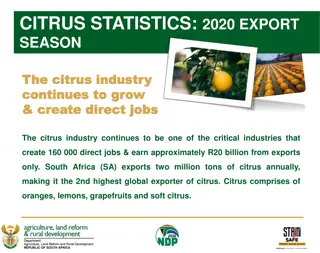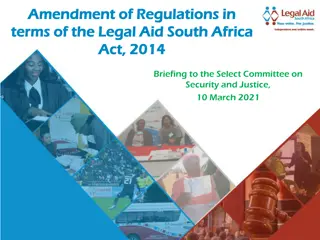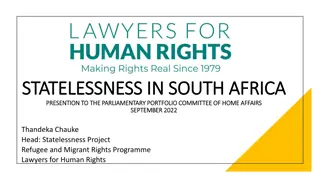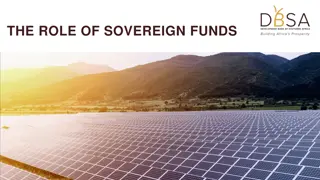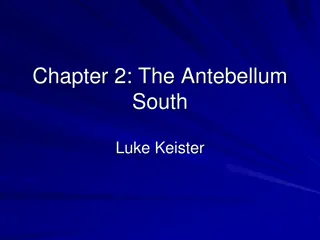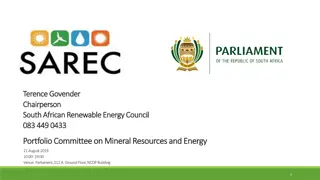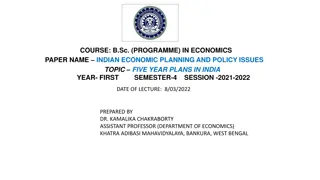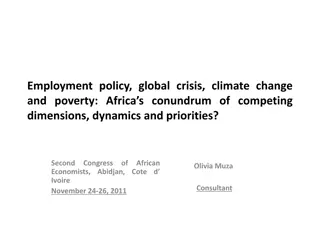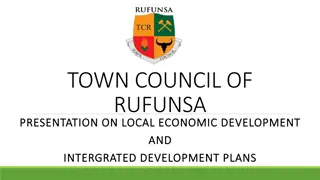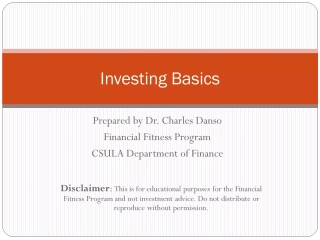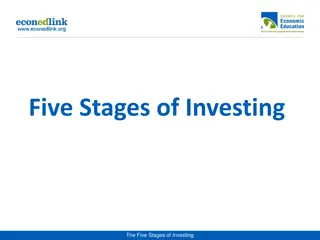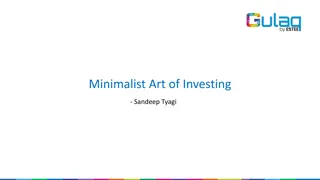Investing in the Republic of South Africa: Economic Overview and Development Plans
The investor presentation highlights South Africa's economic stability, infrastructure development plans, and the implementation of the National Development Plan (NDP) to address poverty and inequality by 2030. Key focus areas include job creation, public sector investments, healthcare initiatives, and strategic frameworks for long-term growth. The medium-term strategic framework (MTSF) aims to align with the NDP's goals and drive progress in education, healthcare, law enforcement, and economic transformation.
Download Presentation

Please find below an Image/Link to download the presentation.
The content on the website is provided AS IS for your information and personal use only. It may not be sold, licensed, or shared on other websites without obtaining consent from the author. Download presentation by click this link. If you encounter any issues during the download, it is possible that the publisher has removed the file from their server.
E N D
Presentation Transcript
THE REPUBLIC OF SOUTH AFRICA Investor Presentation December 2014 1
Table of contents Slide 1) Overview 3 2) Macro economic developments 8 3) Public finance 14 4) Financing of borrowing requirement 21 5) Holdings of government bonds 27 6) Monetary policy 30 7) Banking sector stability 36 2 2
1. Overview 3 3
Key investment highlights Broad political stability will remain, owing to the Congress (ANC)'s dominance at a national and provincial level African National Most developed economy in Sub- Saharan Africa, with total GDP of c.USD309bn in 1H2014 The expenditure ceiling set out in the 2013 Budget has been maintained for the medium term Division of revenue over the medium term is designed to help expand investment in infrastructure Prudent flexible effective inflation targeting regime fiscal exchange management, rate a and an economic Government National Development Plan as the framework for economic and social transformation has adopted the Existing debt has a long maturity structure and its exposure to foreign currency liabilities remains low Major strengths of the economy are its services and sectors and strong infrastructure manufacturing 4 4
National Development Plan (NDP) overview The NDP was established in 2011 in a bid to eliminate poverty and reduce inequality in South Africa by 2030. Some of its key policy objectives are: Jobs Infrastructure Public sector investment to total R847.3 bn over the medium term Independent power producers programme diversifying out of renewables into: gas; hydro; coal; and cross border projects Medupi and Kusile power stations construction underway Transnet to upgrade coal, iron ore and manganese rail lines whilst 29 large bulk water schemes are under construction The new bus rapid transit system will be constructed in nine cities Poverty and Social Wages Community works programme to be established in every municipality Health Target: to create 11 million new jobs by 2030 More than R21 bn allocated to build, refurbish and maintain health related infrastructure Key strategies in place include: Support for smallholder farmers, rural employment programmes and land restitution Two National Health Insurance conditional grants will support contracting doctors and pilot health service innovations in 10 districts - Employment tax incentive - Industrial support programmes and manufacturing incentives - Expanded Public Works Programme Health professions training and development grant will boost the number of health professionals in the public health sector - Special economic zones to promote exports - Support for small, medium and micro enterprises Recruit, train and deploy between 700 000 and 1.3 million community health workers to implement community-based health care 5 5
Medium Term Strategic Framework(MTSF), implementing the NDP Background Priorities over next five years Quality basic education South Africa has begun a new phase of its democratic transition Improved access to basic healthcare Electoral mandate of fifth democratic government is to deepen transformation and implement the NDP More efficient public policing and better law enforcement Skilled and capable workforce to support inclusive growth path Mandate also speaks to accelerating growth, creating employment opportunities and promoting investment in a competitive economy. An economic infrastructure network efficient, competitive and responsive Constitutional commitment to providing improved quality of life for all citizens remains the key cornerstone Purpose Vibrant, communities contributing to food security equitable and sustainable rural Sustainable human settlements and improved quality of household life Strategic plan for the 2014 2019 electoral term Responsive, accountable effective and efficient local government Reflects commitments made in election manifesto of governing party, including commitment to NDP Protect and enhance our environmental assets and natural resources MTSF sets out the actions government will take and targets to be achieved An efficient, effective and development-oriented public service Provides framework for other plans MTSF highlights government s support for a competitive economy 6 6
Summary of the Medium Term Budget Policy Statement ( MTBPS ) The budget policy framework for the next three years is designed to ensure fiscal sustainability while shifting spending towards government s priorities as set out in the NDP and MTSF South Africa s weaker-than-expected economic performance and outlook pose new fiscal challenges GDP growth of 1.4% is expected in 2014, rising to 3.0% in 2017 Government proposes a fiscal package that reduces growth in spending by lowering the 2014 Budget expenditure ceiling by R25`billion over the next two years and adjusting tax policy to generate additional revenue of at least R27 billion over two years The fiscal package results in net debt stabilising at 45.9% of GDP by 2017/18 Overall, public spending will rise by 7.6% a year over the medium-term, with post school education and training, housing development, social infrastructure, employment, labour affairs and social security funds receiving the largest increases Over the medium to long-term, a combination of these fiscal measures and the microeconomic interventions in the Medium Term Strategic Framework will place the economy on a more sustainable development path 7 7
Economy expected to grow as global outlook improves Moderately improving economic growth rates in developed markets are expected to contribute to stronger global demand and international trade but the economic outlook is fragile and uneven 3.9 3.8 3.9 1.4 1.6 1.8 1.5 2.0 2.1 1.3 0.5 0.9 2.6 1.6 1.8 0.4 2.7 2.0 5.9 5.5 5.6 IMF growth projections Region / country Percentage World Advanced economies US Euro area UK Japan Emerging markets and developing countries Brazil Russia India China Sub-Saharan Africa South Africa2 1. IMF World Economic Outlook, October 2014 2. National Treasury forecasts 2013 2014 2015 2016 2013 2014 2015 2016 GDP projections1 Consumer price index projections1 3.3 1.4 2.2 -0.4 1.7 1.5 4.7 3.3 1.8 2.2 0.8 3.2 0.9 4.4 3.8 2.3 3.1 1.3 2.7 0.8 5.0 4.0 2.4 3.0 1.7 2.4 0.8 5.2 3.8 2.0 2.1 1.2 2.0 2.6 5.2 Developed economies: US recovering, but EU and Japan remain weak. There is growing monetary policy divergence. Emerging economies: Growth has been revised downwards due to: rebalancing of growth supply side constraints and reliance on commodity exports 6.8 7.4 7.3 9.5 7.8 7.5 2.6 2.3 2.5 6.6 6.7 7.0 5.8 6.3 5.9 2.5 1.3 5.0 7.7 5.1 1.9 0.3 0.2 5.6 7.4 5.1 1.4 1.4 0.5 6.4 7.1 5.8 2.5 2.2 1.5 6.5 6.8 6.0 2.8 6.2 6.3 5.9 5.6 6.0 6.7 3.0 6.5 5.6 Risks: potential financial markets volatility given different monetary policy responses shifting trade patterns Vulnerability of EMs to fluctuations in capital flows Source: Bloomberg 9 9
GDP growth expected to improve over the medium term Growth expected to be 1.4% this year from 3.6% 2011 due to: work stoppages, labour disputes, electricity constraints and other supply side shocks Macroeconomic forecast , 2011-2017 Calendar year 2 011 2 012 Actual 2 013 2 015 2 016 2 017 2 014 Estimate Forecast Percentage change unless otherwise indicated Final household consumption Final government consumption Gross fixed capital formation Gross domestic expenditure Exports Imports Real GDP growth GDP inflation GDP at current prices (R billion) Nominal GDP growth Headline CPI inflation (Dec 2012 = 100) Current account balance (% of GDP) 2 932.7 -2.3 4.9 4.3 4.2 4.6 6.8 10.0 3.6 5.9 3 139.0 -5.2 3.5 4.0 4.4 4.0 0.4 6.0 2.5 4.5 3 385.4 -5.8 2.6 2.4 4.7 2.2 4.2 4.7 1.9 5.8 3 642.6 -5.6 1.9 1.8 2.7 0.9 3.1 1.0 1.4 6.1 3 952.6 -5.4 2.3 1.5 3.6 2.6 4.2 4.1 2.5 5.8 4 295.8 -5.2 2.8 1.5 4.7 3.0 4.7 5.0 2.8 5.7 4 675.6 -5.0 3.0 1.5 5.1 3.3 5.2 5.6 3.0 5.6 It is expected to pick up to 3.0% in 2017 as the global outlook improves, confidence returns to the economy as constraints are relieved Key drivers to growth pick-up: increased particular from key trading partners such as Europe and Africa easing in constraints (Medupi power station under construction) export demand, in electricity supply 9.7 5.0 7.0 5.7 7.8 5.8 7.6 6.3 8.5 5.9 8.7 5.6 8.8 5.4 Key constraints: - consumers remain under pressure and low consumer confidence Source: National Treasury, SARB 10 10
The current account is expected to narrow Current account deficit ( CAD ) is projected to narrow from 6.0 per cent in 2013 to 5.5 per cent in 2016 as export growth improves Although the CAD has recently widened, this was primarily driven by infrastructure related imports and a worsening in terms of trade Capital and financial accounts sufficiently financed the CAD last year Current account as percentage of GDP Percentage of GDP 2007 2008 2009 2010 2011 2012 2013 2014 Dec-13 Mar-14 Jun-14 Total current account (saar values) -7.0 -7.2 -4.0 -2.0 -2.3 -5.2 -5.9 -5.4 -5.1 -4.5 -6.2 Trade balance Net services, income and transfer receipts Net service receipts -1.8 -1.6 0.1 1.9 1.6 -1.3 -2.2 -2.5 -1.3 -2.1 -2.8 -5.2 -5.6 -4.1 -3.8 -3.9 -4.0 -3.7 -2.9 -3.8 -2.4 -3.4 -0.9 -1.5 -1.0 -1.2 -1.2 -0.7 -0.6 -0.4 -0.5 -0.5 -0.4 Net income receipts -3.4 -3.3 -2.2 -2.0 -2.3 -2.3 -2.1 -1.6 -2.6 -1.1 -2.0 Net dividend payments -3.1 -2.6 -1.6 -1.5 -1.9 -1.8 -1.5 -0.9 -2.1 -0.4 -1.4 Net transfer payments (mainly SACU) Current account excluding SACU transfers -0.8 -0.8 -0.9 -0.6 -0.5 -1.0 -0.9 -0.9 -0.7 -0.8 -1.0 -6.1 -6.3 -3.1 -1.3 -1.8 -4.2 -4.9 -4.5 -4.4 -3.7 -5.2 11 11
Traditional exports are under pressure, but new opportunities are emerging Growth of exports to EU expected to be muted Major export destinations for South African products Table 2.3 Major export destinations for South African products, 2000 2014 20141 20141 2013 2000 2012 2013 Commodity exports to China expected to be weak Contribution to export growth 3.0 0.6 0.6 0.8 -0.3 -0.0 4.0 2.5 1.1 0.5 0.6 0.5 1.2 -1.4 2.8 12.4 % Share EU 4.3 0.9 0.9 0.7 1.2 -0.0 -0.0 1.3 -0.2 -0.7 -1.6 31.3 7.8 8.9 3.3 1.4 0.7 2.0 9.8 2.3 2.2 2.0 12.0 8.1 15.2 19.6 100.0 20.6 5.4 3.9 3.5 4.3 0.9 11.6 12.9 2.7 2.7 2.9 8.8 6.3 11.0 23.7 100.0 21.0 5.3 4.0 3.8 3.6 0.8 13.9 13.7 3.4 2.8 3.1 8.3 6.7 8.5 23.5 100.0 23.5 5.9 4.4 4.5 4.8 0.8 12.6 13.6 3.7 2.8 3.2 8.1 5.7 7.1 23.8 100.0 Germany UK Netherlands India Brazil China SADC Mozambique Zimbabwe Zambia US Japan Unallocated2 Other3 Total 1. First seven months of 2014 2. Commodities, such as gold, sold through exchanges 3. Includes Hong Kong, Korea, Singapore, Malaysia, Australia, Nigeria, Ghana, Angola, Egypt and United Arab Emirates Source: Quantec But SADC exports are diversified and growing strongly SADC becoming increasingly important export destination, especially for manufactured goods 0.5 0.3 0.4 Other export opportunities emerging, with rising share of non-traditional markets (other) 2.1 6.5 There are negotiations to finalise the tripartite FTA, which consist of SADC, EAC and COMESA. If concluded this will result in a market of nearly 1 billion people. 12 12
SA increasing exports and investments towards African region key for current account structure Africa important trade partner, absorbing 28.5 per cent of South African exports, up from 22.6 per cent in 2002 is increasingly becoming an South African trade and investment with Africa 2002 5.5 22.6 2.0 2007 12.6 23.0 11.5 2012 24.3 28.2 12.0 2013 32 28.6 14.9 Annual investments into Africa (R billion) Exports (% of SA total) Dividend receipts from Africa (% of total) Africa has become a major investment destination for South Africa firms and source of earnings. Investments into Africa increased from R5.5 bn in 2002, to R32.3 bn in 2013 Source: SARB and South African Revenue Services South African trade (incl BLNS 1) with Africa 300 1 Government has taken several steps to promote export potential: 250 200 R billion Improved pricing at local ports to reduce transport costs and enhance competitiveness Invested in infrastructure to reduce production and transport bottlenecks Put in place initiatives in manufacturing SA DFIs funding infrastructure on the continent to support trade relations 150 100 50 0 2009 2010 2011 2012 2013 competitiveness Excl BLNS Incl BLNS Source: South African Revenue Service (Botswana, Lesotho, Namibia, Swaziland1) 13 13
3. Public Finance 14 14
Fiscal framework remains sound and transparent Overview Fiscal priorities Maintaining the expenditure ceiling Reducing the budget deficit Stabilisation of debt over the medium term Improving the composition and efficiency of spending Cost-containment measures announ- ced by the Minister of Finance in October 2013 limit expenditure on conferences, travel, entertainment and other non-essential items The National Treasury and Department of Performance Evaluation have launched a series of expenditure reviews Fiscal framework grounded in sustainable, countercyclical approach to managing revenue and expenditure Government intends to balance continued support for economic recovery with fiscal consolidation Key social and economic programmes are expected to be maintained, complemented by efforts to improve value for money Spending is expected to be contained over the medium term expenditure framework period Reduction of the deficit will be a combined result of government s expenditure ceiling and revenue measures As economic growth improves and spending limits stay in place, the budget deficit is projected to narrow to 2.5 per cent of GDP by 2017/18 Monitoring and Tax Review Committee is investigating all aspects of the tax system to improve equity and efficiency 15 15
Proposed fiscal package to reinforce sustainability In order to narrow the deficit and stabilise debt over the medium term, government proposes a fiscal package with the following five elements: Reduce growth in spending by lowering the 2014 Budget expenditure ceiling by R25`billion over the next two fiscal years Adjust tax policy and administration. Proposals will be introduced in the 2015 Budget to generate additional revenue of at least R27 billion over the next two fiscal years Place greater emphasis on longer-term planning and efficient resource allocation, within a framework that links expenditure and economic growth beyond the medium term Freeze government personnel headcount. Government will also review funded vacancies Adopt a deficit-neutral approach to the financing requirements of state-owned companies over the next two fiscal years 16 16
Fiscal framework including the proposed fiscal package Consolidated fiscal framework, 2011/12 2017/18 2011/12 2012/13 Outcome 2013/14 2014/15 2015/16 Medium-term estimates 2016/17 2017/18 R billion/Percentage of GDP Main budget Revenue Expenditure of which Non-interest allocations Debt-service costs Unallocated reserves Main budget balance Budget Revised 745.3 889.9 799.2 965.5 886.1 1 047.8 962.8 1 142.6 956.6 1 136.3 1 055.1 1 222.3 1 169.4 1 308.4 1 272.9 1 416.7 813.5 76.5 -144.6 -4.9% 33.8 877.4 88.1 -166.3 -5.2% 30.1 946.6 101.2 -161.7 -4.7% 27.0 1 024.7 114.9 -179.8 -4.7% 26.7 1 021.9 114.5 -179.7 -4.8% 26.5 1 090.8 126.5 -167.2 -4.1% 22.7 1 153.9 139.4 15.0 -139.0 -3.2% 25.0 1 222.0 149.7 45.0 -143.8 -3.0% 25.0 3.0 5.0 Cash balances of social security funds, public entities and provinces Consolidated budget balance -110.8 -136.2 -134.7 -153.1 -153.2 -144.5 -114.1 -118.7 -3.7% -4.3% -3.9% -4.0% -4.1% -3.6% -2.6% -2.5% Source: National Treasury 17 17
Spending continues to grow in real term, while reaching a primary balance within the current MTEF Main budget non-interest spending Main budget primary balance 16 30 Revenue Non-interest expenditure 14 28 13.5 12 12.1 26 Per cent real growth 10 10.8 10.19.7 Per cent of GDP 8.9 8 24 8.4 6 22 4 4.2 20 3.2 2.9 2 2.2 2.01.6 1.3 1.1 0 18 2003/04 2004/05 2005/06 2006/07 2007/08 2008/09 2009/10 2010/11 2011/12 2012/13 2013/14 2014/15 2015/16 2016/17 2017/18 1996/97 1998/99 2000/01 2002/03 2004/05 2006/07 2008/09 2010/11 2012/13 2014/15 2016/17 Source: National Treasury 18 18
Net national government debt stabilising in 2017/18 Before the proposed changes, national government s net debt was projected to continue growing as a share of GDP beyond 2021 Net national government debt 50 MTBPS 2012 MTBPS 2013 MTBPS 2014 before fiscal package MTBPS 2014 including fiscal package 45 The fiscal package results in net debt stabilising at 45.9 per cent of GDP in 2017/18, while gross debt remains below 50 per cent of GDP 40 Per cent of GDP 35 30 Projections 25 20 2007/08 2008/09 2009/10 2010/11 2011/12 2012/13 2013/14 2014/15 2015/16 2016/17 2017/18 2018/19 2019/20 2020/21 Source: National Treasury 19 19
Risks to the proposed fiscal framework Economic outlook: Rising global interest-rate cycle likely to place pressure on domestic interest rates, increasing the costs of issuing debt The current account deficit remains persistently high, making SA more vulnerable to shifts in investment flows and market sentiment A further deterioration in the GDP would require consideration of additional measures Electricity constraints impact on growth Government s wage bill: Budgets assume CPI cost-of-living adjustments and headcount numbers at current levels Current constraints suggest limited scope for additional resources Deviations from CPI-linked cost-of-living adjustments will require either a reallocation of resources or a reduction in government employment A new framework for funding of SOCs and public entities will focus on: Distinguishing purely commercial activities from the costs of exercising their developmental mandates Close monitoring to ensure efficient delivery on government priorities, while simultaneously promoting improved commercial performance Introducing more stringent financial reporting requirements for public entities Capitalisation will be funded from sale of non-strategic state assets, and will not be drawn from tax revenue 20 20
National government gross borrowing requirement and financing Budget balance to moderate to R143 billion in 2017/18 Funding to be raised largely from the domestic bond market Bond issuance remains at current levels over next 2 fiscal years increasing to R176.9 billion in 2017/18 due to higher redemptions Loan redemptions projected to total R155 billion over medium-term Financing of national government borrowing requirement, 2013/14 2017/18 2013/14 Outcome -161,701 2014/15 2015/16 Medium-term estimates 2016/17 2017/18 R million Main budget balance1 Financing Domestic short-term loans (net) Treasury bills Corporation for Public Deposits Domestic long-term loans (net) Market loans (gross) Loans issued for sw itches2 Redemptions Foreign loans (net) Market loans (gross) Redemptions (including revaluation of loans) Change in cash and other balances3 Total Source: National Treasury Budget -179,781 Revised -179,711 -167,187 -139,016 -143,770 23,048 20,221 2,827 149,414 172,112 -1,135 -21,563 19,619 -19,241 23,000 23,000 132,098 167,103 -35,005 1,288 16,290 -15,002 153,926 187,360 -33,677 8,263 22,952 -14,689 10,000 10,000 13,000 13,000 137,712 165,500 -27,788 5,879 9,826 -3,947 24,000 24,000 107,694 165,500 -57,806 3,418 16,635 -13,217 40,000 40,000 88,845 176,914 -88,069 12,406 16,005 -3,599 243 378 -11,139 161,701 23,395 179,781 7,522 179,711 10,596 167,187 3,904 139,016 2,519 143,770 22 22
Cash balances to finance part of the borrowing requirement Changes in cash balances,2013/14 - 2017/18 2013/14 Outcome 2014/15 2015/16 Medium-term estimates 2016/17 2017/18 Budget Revised R million Rand currency Opening balance Closing balance of which: Tax and loan accounts Change in rand cash balance1 (opening less closing balance) Foreign currency2 Opening balance Closing balance US$ equivalent Change in foreign currency cash balance1 (opening less closing balance) Total change in cash balances1 Total closing cash balance 1. A negative value indicates an increase in cash balances and a positive value indicates that cash is used to finance part of the borrowing requirement 2. Rand values at which foreign currency was purchased or borrowed 103,774 120,807 123,157 107,157 120,807 112,157 112,157 112,157 112,157 107,157 107,157 107,157 53,650 -17,033 40,000 16,000 45,000 8,650 45,000 40,000 5,000 40,000 63,828 63,087 7,990 63,254 60,359 7,522 2,895 63,087 68,714 8,163 -5,627 68,714 63,341 7,522 5,373 63,341 68,996 7,522 -5,655 68,996 70,904 7,522 -1,908 741 -16,292 183,894 18,895 167,516 3,023 180,871 5,373 175,498 -655 -1,908 178,061 176,153 Source : National Treasury 23 23
Debt-service cost stabilises over the medium term Debt service cost 6 25 Per cent of GDP (right axis) Per cent of revenue and expenditure 23 5 Per cent of revenue 21 Per cent of expediture 5 19 Per cent of GDP 4 17 15 4 13 3 11 3 9 2 7 2014/15 Description 2013/14 2015/16 2016/17 2017/18 Medium - term estimates 2018/19 2019/20 2020/21 Budget Revised 106 424 92 387 14 037 114 485 Domestic Bonds Short-term Foreign Total debt service cost 93 207 81 464 11 743 7 978 101 185 106 212 91 394 14 818 8 689 114 901 117 149 101 422 15 727 126 537 129 655 111 130 18 525 139 449 139 935 118 754 21 181 149 684 150 748 126 772 23 976 10 564 161 312 165 408 138 807 26 601 12 001 177 409 178 518 149 292 29 226 10 085 188 603 8 061 9 388 9 794 9 749 % of GDP % of Revenue % of Expenditure 2.9% 11.4% 9.7% 3.0% 11.9% 10.1% 3.1% 12.0% 10.1% 3.1% 12.0% 10.4% 3.2% 11.9% 10.7% 3.1% 11.8% 10.6% 3.1% 11.6% 10.5% 3.1% 11.7% 10.6% 3.1% 11.4% 10.4% Source : National Treasury 24 24
Stabilised borrowing costs since April 2014 Long-end of the curve flattening but remains steep on the short-end Due to foreign and local demand in the long end Fixed-rate bond yield curve movement R2023 R186 R208 Compared to April 2014, yields have strengthened Fixed-rate bonds by approx. 70 basis points on average Inflation-linked bonds by approx. 9 basis points on average Inflation-linked bond yield curve movement Strategy to issue long adopted in order to Minimize refinancing risk and Accommodate the elevated funding requirement Strategy consistent with borrowing for infrastructure and adheres to inter- generational equity principle Source: SA National Treasury 25 25
Debt portfolio risk benchmarks for prudent debt management Risk guidelines have been reviewed to ensure: Debt sustainability That the portfolio is resistant to market shocks New parameters are medium term guidelines rather than hard targets No plan to aggressively shift current portfolio towards new guidelines Debt portfolio risk benchmarks Fixed-rate bonds Average Term to Maturity Limit Range of 10-14 years Inflation-linked bonds Average Term to Maturity Range of 14-17 years Total Long term Debt Share of debt maturing in 12 Months incl. T-bills Share of debt maturing in 5 years excl. T-bills Share of ILB's as a percentage of total domestic debt Foreign debt as a percentage of total Debt Limit to 15 per cent of total domestic debt Limit to 25 per cent of total domestic debt Range of 20-25 per cent Limit of 15 per cent Source: National Treasury 26 26
Non-resident holdings increased significantly since the 2008 crisis and remains resilient Holdings of domestic government bonds (%) , 2008 Sept 2014 Non-resident holdings recorded 37.1% (R454bn) ($41.6bn) as at end of Oct 2014 Increased from 35.7% in January Indications suggested that holdings in 2014 might decline, however, they have remained resilient, reaching a high of 38.8% in July 2014 in January 2014 Source: Share Transaction Totally Electronic LTD(Strate) 28 28
Holdings of fixed-rate and inflation-linked government bonds Ownership of fixed-rate bonds and inflation-linked bonds by sector, Oct 2014 Non-residents account for 46% of fixed-rate bonds holdings Non-resident are overweight in the short to mid end of the curve, owning more than 50% of R203, R204 ,R207, R208 bonds and R2023 Also starting to buy the long of the curve, owning more than 50% of the R214 100 80 Per cent 60 63% 4% 40 As expected long-term insurers overweight at the long-end of the curve 46% 20 17% 25% 7% 9% 1% 1% 12% 9% 7% 0 The bulk of the inflation-linked bonds are owned by pension funds and monetary institutions Together accounting for about 65% of the total outstanding debt Pension funds Foreign investors Monetary institutions Other financial institutions Insurers Other Fixed-rate bonds Inflation-linked bonds Non-residents only owning 4% of the total debt outstanding Source: STRATE, SA National Treasury Long-term and short-term insurers are underweight inflation linkers with combined ownership of 5% 29 29
6. Monetary Policy 30 30
Inflation profile Inflation peaked earlier-than-expected at 6,6 per cent in May and June before receding to within the target, at 5,9 per cent in September and October 2014 Targeted and core inflation This was influenced by petrol price inflation falling from a high of 14,3 per cent in May to a low of 1,1 per cent in September Food prices have begun moderating more recently following bumper domestic and global grain harvests Core inflation reflects continued second round effects from a lengthy period of rand depreciation, and persistently high inflation expectations Demand-side pressures remain subdued as disposable income, employment and credit extension to households remains weak Headline inflation is expected to average 6,1 per cent in 2014, 5,3 per cent in 2015 and 5,5 per cent in 2016 Source: SARB, 2014 31 31
ZAR exchange rate The exchange rate of the rand has experienced bouts of volatility and relative calm along a generally depreciating path since 2011 pushing the cost of imported goods higher Exchange rate movement Global factors influencing rand movements include the timing and pace of policy normalisation in the US and UK, countered by current and potential future policy easing that may occur in the euro area and Japan leading to volatile non-resident investment flows Domestic influences include the extended strikes during the first seven months of the year which resulted in weak economic performance, a persistent current account deficit and the response of the market to the sovereign downgrade by Moody s Rand movements and inflation The rand is expected to remain sensitive to changes in sentiment, global economic and policy outcomes and domestic performance Although it remains an upside risk to inflation, pass- through to inflation has been relatively muted to date Source: SARB, 2014 32 32
Food and petrol prices Food and petrol prices comprise just under 20 per cent of total inflation Estimated contribution of food and petrol price changes to headline inflation Bumper maize harvests domestically and globally have brought down grain prices significantly Meat inflation remains high as herd restocking occurs in the region The petrol price has fallen over 8 per cent since April Food and petrol prices are expected to continue moderating in the near term, in line with weaker global trends Source: SARB, 33 33
Wage settlements and inflation expectations Unit labour costs (first nine months of 2014) Wage settlements pose an upside risk to the inflation outlook but have been relatively stable around 8 per cent during 2014. However, unit labour costs have been distorted due to the extended strikes and national election in the second quarter Inflation expectations for the medium term have been fairly stable, just above the inflation target. However, they vary significantly across respondents with analysts expecting inflation within the target range for 2015 and 2016, while expectations of unions and business people are somewhat higher Inflation expectations The public sector wage settlement will be critical in determining the trend of wage settlements in the coming year. The MPC remains concerned about the apparent delinking of wage demands from inflation and productivity Source: SARB 34 34
Monetary policy stance Nominal and real repo rate Monetary policy has begun adjusting to more normal interest rate levels with repo rate increases in January and July 2014 Risks to the inflation forecast, as at November 2014, are seen to be more or less balanced, with downside risks from continued oil price weakness and anaemic demand, and upside risk from the exchange rate, and possible continued high wage settlements Monetary policy remains accommodative against the backdrop of a weak economy, but normalisation is inevitable. Rate decisions will rely on a number of factors including the evolution of inflation expectations, the inflation outlook, the speed of normalisation in the US, and the pace of the domestic recovery Source: SARB 35 35
Sound and stable banking system Total assets and gross loans and advances Total assets grew by 9,55 per cent y-o-y in September 2014 to R4,2 trillion South African banking sector is adequately capitalised with high ratio of loss absorbing capital Banking sector continues to generate sound profitability levels Unsecured lending (retail asset classes) growth has moderated from 18,7 per cent in September 2013 to 5,3 per cent in September 2014 Total unsecured lending constitutes slightly less than 12 per cent of total credit exposure (similar to September 2013) Selected indicators of SA banks (Sep 2014) Total capital adequacy ratio (CAR) Tier 1 CAR Common equity tier 1 CAR Gross loans and advances Impaired advances Impaired advances to gross loans and advances (smoothed) 14,23% 11,61% 11,07% R3,2 tn R107,5 bn 3,35% 1,04% 14,08% 54,37% 8,43% 198,22% Credit quality for the sector has continued to improve impaired advances to gross loans and advances declined by 36 basis points y-o-y to 3,35 per cent in September 2014 specific credit impairments (or provisions) continued to increase Return on assets (smoothed) Return on equity (smoothed) Cost-to-income ratio (smoothed) Liquid assets to total assets Liquid assets held to liquid asset ratio Source: SARB 37 37
The banking sector is efficient Cost-to-income ratio and jaws ratio The jaws ratio decreased from 3,6 per cent at the end of September 2013 to -4,3 per cent at the end of September 2014 owing to a decline in the growth rate of income to 7,1 per cent at the end of September 2014 compared to 11,9 per cent at the end of September 2013 The banking sector s cost-to-income ratio (smoothed over a 12-month period) increased from 52,3 per cent at the end of September 2013 to 54,4 per cent at the end of September 2014 the increase is mainly due to the growth in operating expenses exceeding the growth in operating income (operating income growth slowed mainly due to lower trading income) Profitability in the sector (as measured by the ROE) declined from 16,4 per cent in September 2013 to 14,1 per cent in September 2014 Source: SARB the decline was mainly due to credit losses sustained by African Bank 38 38
Sound and stable banking system Total assets and gross loans and advances of the banking sector are growing at sustainable levels South African banking sector remained adequately capitalised The sector is profitable with higher quality of assets Impaired advances ratio is lower Provisions have been increasing The sector s total unsecured gross retail credit exposure was approximately 12 per cent of total gross credit exposure The Regulations relating to Banks include the phased-in requirements contained in the Basel III framework the sector is on track to implement the Liquidity Coverage Ratio (LCR) from January 2015 39 39
THANK YOU 40 40
